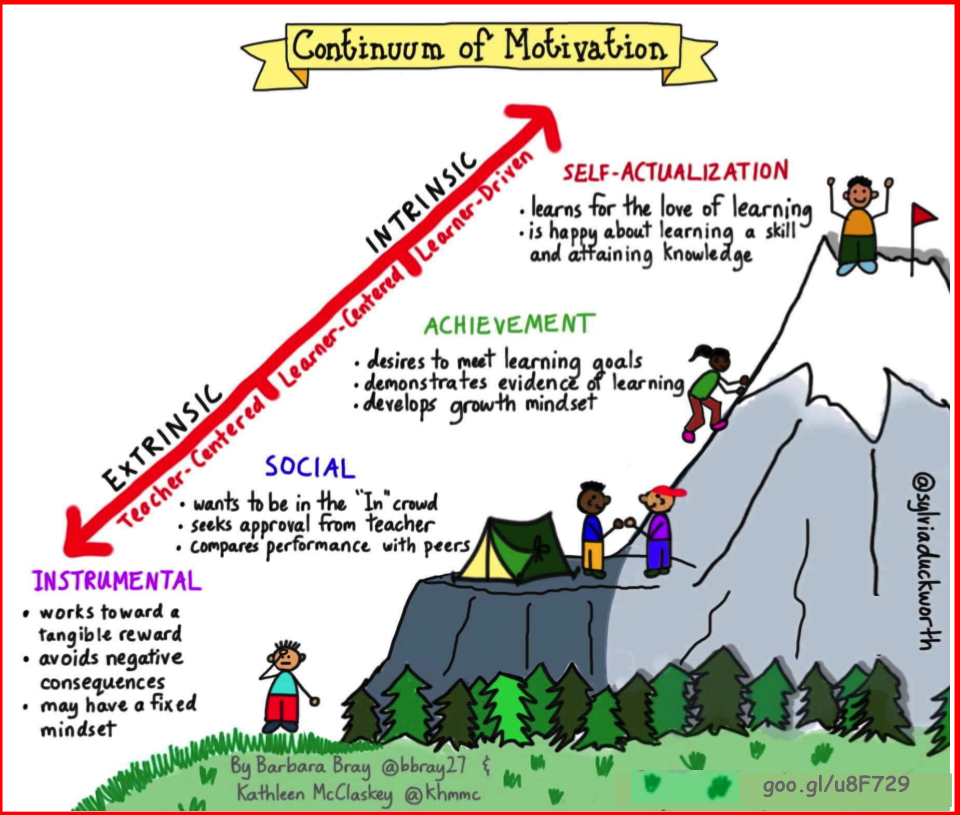
The Continuum of Motivation graphic created by Sylvia Duckworth @sylviaduckworth with original content from Barbara Bray @bbray27 and Kathleen McClaskey @khmmc updated by Barbara is licensed under a Creative Commons Attribution-NonCommercial-NoDerivatives 4.0 International License.
The Continuum of Motivation graphic above is a snapshot of what moving from extrinsic motivation to intrinsic motivation might look like as learners progress through the learning process. I updated the original content to add ideas that demonstrate the continuum of the learning process and how learners can build confidence as they climb to the top of the mountain to self-actualization.
Extrinsic motivation occurs when we are motivated to perform a behavior or engage in an activity to earn a reward or to avoid punishment. Intrinsic motivation involves engaging in the behavior because it is personally rewarding; essentially, performing an activity for its own sake rather than the desire for some external reward. While some people learn more from outside influences, others may achieve more through their personal aspirations. Motivation has a great impact on the learning process. Whatever the situation, everyone involved in any learning process will probably want to know how motivation affects learning.
Instrumental
Instrumental is a similar system in education as the factory model that encourages rewards and consequences instead of self-discovery. Most of us are used to this system that we became comfortable with it and find it difficult to change. “Students” especially high school students may ask questions like “what is my grade?” or “is this going to be on the test?” Some “students” know how to “do” school to get through school. Others just want to follow the rules where others are not motivated because they lost interest, do not feel successful, are bored with school or feel no connections to the teacher, school or learning. I’ve even heard this: “just tell me what to do to learn.” I call this “learned helplessness.”
Social
Social is where learners want to be accepted as part of a group more than focus on what they are learning. At this level, learners may seek approval of their peers. They may want to please the people that mean the most to them; their parents, teachers, and peers. They are more motivated by looking good than focusing on what they are learning. They tend to measure how they perform with others especially their peers. Friends may mean more to them then what they learn or how they do in school. In this level, they are motivated to learn driven mostly by extrinsic factors.
Achievement
Achievement means learners demonstrate that they want to learn and have a desire to succeed in school. This is also where they want to work well and be successful more than being one of the in-crowd. This is where they may find something they are interested in and want to learn more. They may even create or choose the evidence that demonstrates mastery of their learning. When they are more invested in their learning, they may create their own learning goals. They may even be excited to show how they met those learning goals. This is where they begin developing a growth mindset by believing in themselves. They are starting to realize that they can learn if they put their mind to it.
Self-Actualization
Self-Actualization is about learners being completely invested in their learning. They are involved and immersed in the learning process because of their love of learning. At this point, a learner’s eyes are open to the idea that it is all about them and how they learn that drives them to want to learn more. It could be learning a new skill, attaining new knowledge, creating something they never thought they could build, or pursuing their purpose. In self-actualization, they have agency and know they can learn anything they want to learn if they put their heart, mind, and soul into it.
*****
Thank You to Sylvia Duckworth @sylviaduckworth (http://sylviaduckworth.com) from Toronto, Canada for designing the original graphic of the Continuum of Motivation in 2016.
*****
More Continuums




[…] Continuum of Motivation […]
[…] Continuum of Motivation […]
[…] Continuum of Motivation […]